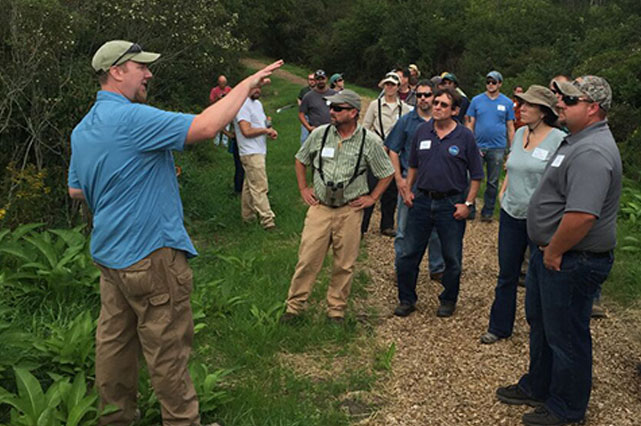USDA Farm Bill


For decades, the USDA Farm Bill has supported the voluntary conservation efforts of private landowners; it is the most important tool enacted by Congress for conserving habitat on private lands. Farm Bill conservation programs fund easements to protect agricultural lands, efforts to protect at-risk species on working lands, technical advisors to help landowners improve their operations while conserving natural resources, and much more. The 2018 Farm Bill expands funding for Environmental Quality Incentives Program (EQIP), and the Regional Conservation Partnership Program (RCPP), which can streamline collaboration between conservation organizations, farmers, and industry. The 2018 Farm Bill also expands acreage of the Conservation Reserve Program (CRP) to 27 million acres.
Under the Farm Bill, the Natural Resources Conservation Service (NRCS) has several incentive programs that assist landowners, land trusts, and other conservation organizations with implementing habitat conservation. NRCS’ EQIP is a financial and technical assistance program funded through the Farm Bill that helps landowners cover the expense of managing their land for wildlife habitat by implementing approved conservation practices. EQIP can also act as a resource for land trusts and landowners by providing information about management practices that optimize environmental benefits on working agricultural land and non-industrial forestland.
For example, funding may be targeted to improve habitat quality for a species of concern like the Golden-winged Warbler through the Working Lands for Wildlife program, a partnership program under EQIP between NRCS and the U.S. Fish and Wildlife Service. To restore shrubland and young forest habitat for Golden-winged Warblers and other wildlife, EQIP conservation practices fall into two categories: shrubland—restoration through succession resets, or forestry—improving forest stewardship and wildlife habitat. Within these two categories are a variety of potential habitat management practices, including selective tree cutting, wildlife opening, an even-aged stand cut, feathered edge, brush management, invasive plant treatment, and shrub establishment.
The recommended first step for a land trust or other private landowner with interest in applying for a USDA-NRCS conservation program is to stop by your local NRCS office to talk to a conservation planner. Discuss the goals for your land and decide which program and conservation practices best address these goals and existing resource concerns. Then complete an NRCS-CPA-1200 program application. Applications are ranked for funding according to resource concerns addressed and the amount of conservation benefit the practices will provide. Applicants may reapply every year if not initially funded.
A terrific resource for understanding Farm Bill programs and funding opportunities is the Farm Bill Field Guide created by the Appalachian Mountains Joint Venture. NABCI’s State of the Birds Farm Bill Special Report and All Bird Bulletin updates are other effective resources that can guide landowners, land trusts and bird conservation entities looking to conserve birds in agricultural habitats. The USDA also published a Farmer’s Guide to Farm Bill Programs that describes assistance for farmers, ranchers, and forest managers available through the 2018 Farm Bill.
Farm Bill Conservation Programs for Land Trusts
- Agricultural Conservation Easement Program (ACEP) provides financial and technical assistance to help conserve agricultural lands and wetlands and their related benefits. Land trusts can utilize the program to access matching funds to purchase conservation easements on agricultural land, grasslands, and wetlands.
- Healthy Forest Reserve Program (HFRP) helps landowners restore, enhance and protect forestland resources on private lands through easements and financial assistance. Land trusts can utilize the program if their projects benefit endangered species, improve biodiversity, or enhance carbon sequestration.
- Forest Legacy Program (FLP) is a partnership between the Forest Service and State agencies with the goal of encouraging the protection of privately owned forest lands through conservation easements or land purchases.
- Community Forests Program allows communities to acquire and conserve forests that provide public access and recreational opportunities, protect vital water supplies and wildlife habitat, serve as demonstration sites for private forest landowners, and provide economic benefits from timber and non-timber products.
- Environmental Quality Incentives Program provides financial and technical assistance to agricultural producers to address natural resource concerns and deliver environmental benefits such as improved water and air quality, conserve ground and surface water, reduced soil erosion and sedimentation, and improved or created wildlife habitat. Land trusts can apply for funding through EQIP for conservation projects.
- Also see Conservation Innovation Grants that drive public and private sector innovation in resource conservation. These competitive grants inspire creative problem-solving ultimately boosting production on farms, ranches, and private forests and improving water quality, soil health, and wildlife habitat.
- Conservation Stewardship Program helps agricultural producers maintain and improve their existing conservation systems and adopt additional conservation activities to address priority resources concerns. Participants earn CSP payments for conservation performance.


